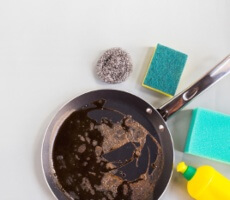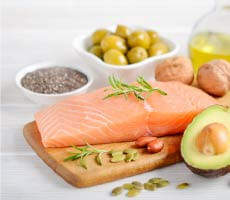1 in 4 Americans Don't Wash Their Produce and Haven't Sanitized Their Fridge Drawers in Over Six Months [Survey]

With so many differences of opinion when it comes to the proper way of washing produce, and whether or not it makes a difference, it's difficult to know if we're following the right recommendations. One theory is that cooking your vegetables is more than enough to kill germs and bacteria, therefore, skipping a rinse is not a big deal. Others, swear by certain products like baking soda, vinegar, or produce disinfectants to keep their fruits and vegetables clean. On the other hand, studies also point out that cross-contamination with other germy areas in your kitchen, like your sink, often pose a threat to harmful bacteria like Salmonella and E. coli.
To find out what actually goes down in America's home kitchens, we surveyed 1,500 people on their produce and kitchen cleaning habits. With the surprising results from our survey and the recent change in grocery shopping behavior brought on by COVID-19, we put together a guide that highlights the germiest spots in grocery stores and household kitchens that often come in contact with produce.
Keep reading to find the rest of the results from our survey, spots to avoid or routinely clean around your kitchen, and the recommended way to keep your fruits and veggies clean before you use them to cook your next delicious meal.
Americans' Produce & Kitchen
Hygiene Habits
On average, Americans spend about 215 hours per year preparing food and a little over 435 hours each year eating and drinking. With so much time being spent around handling and consuming food, and the increasing risks of foodborne illness outbreaks, it's important to be aware of our habits in the kitchen in case we need to pivot to better sanitizing practices.

Fortunately, about 73 percent of respondents in our survey regularly wash their fruits and veggies. However, over 20 percent still reported that they don't wash their produce, even in the midst of COVID-19.
Although a good portion of respondents get a thumbs up for washing their produce, they seemed to have missed the mark on regularly sanitizing the area where that produce lives until you eat it, since one in four Americans haven't sanitized their refrigerator drawers in over six months!
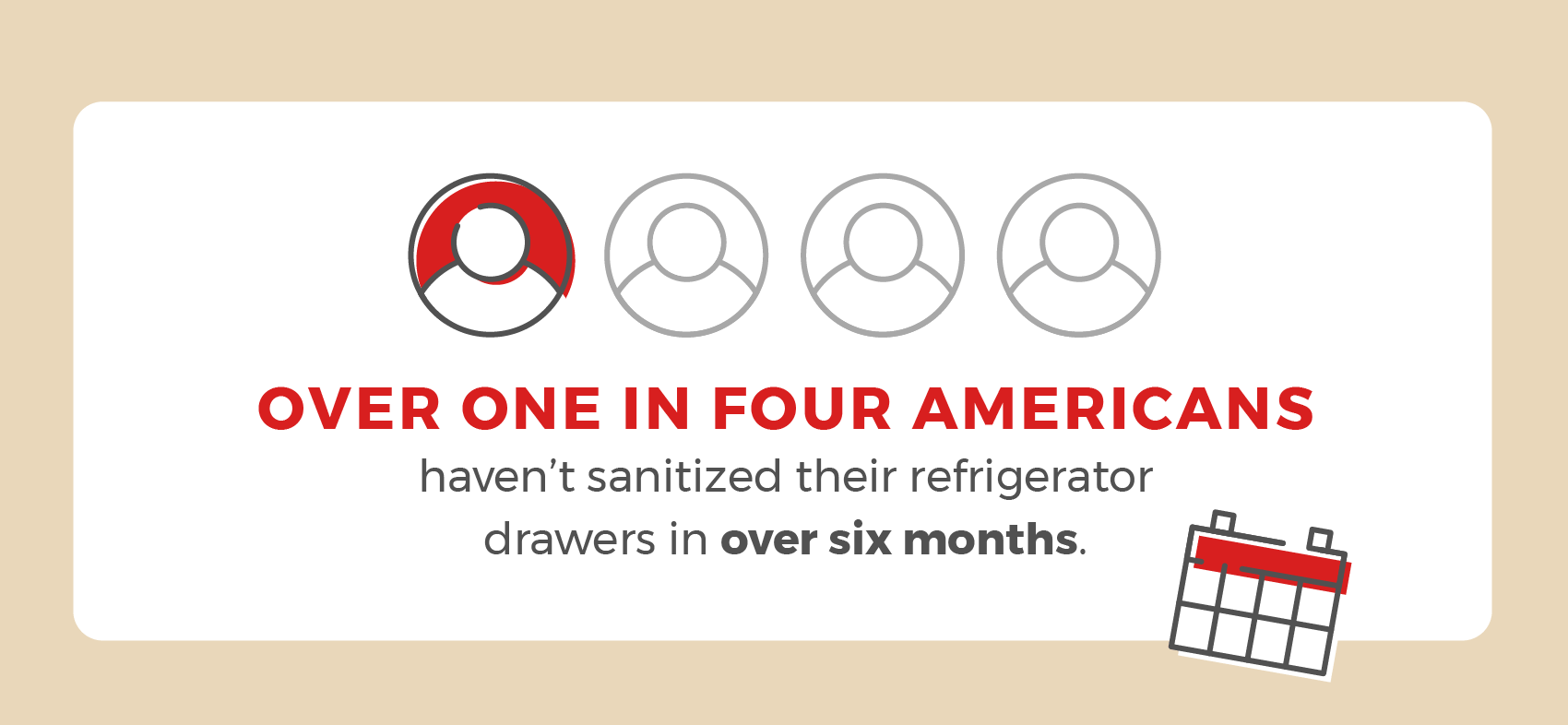
With ideal conditions in refrigerator drawers like temperature, moisture, nutrients, and a lack of sunlight, one bacterium, like E.coli, can generate over two million bacteria in seven hours. Certain strains are also very resistant to heat, UV rays, and disinfectants, making them incredibly difficult to get rid of, especially on food.
So for how long are people allowing their refrigerator drawers to grow gross and potentially harmful germs? Here's how often people are sanitizing their vegetable drawers:
- Every two weeks: 10 percent
- Once a month: 17 percent
- Every six months to a year: 26 percent
- Only if food spoils: 15 percent
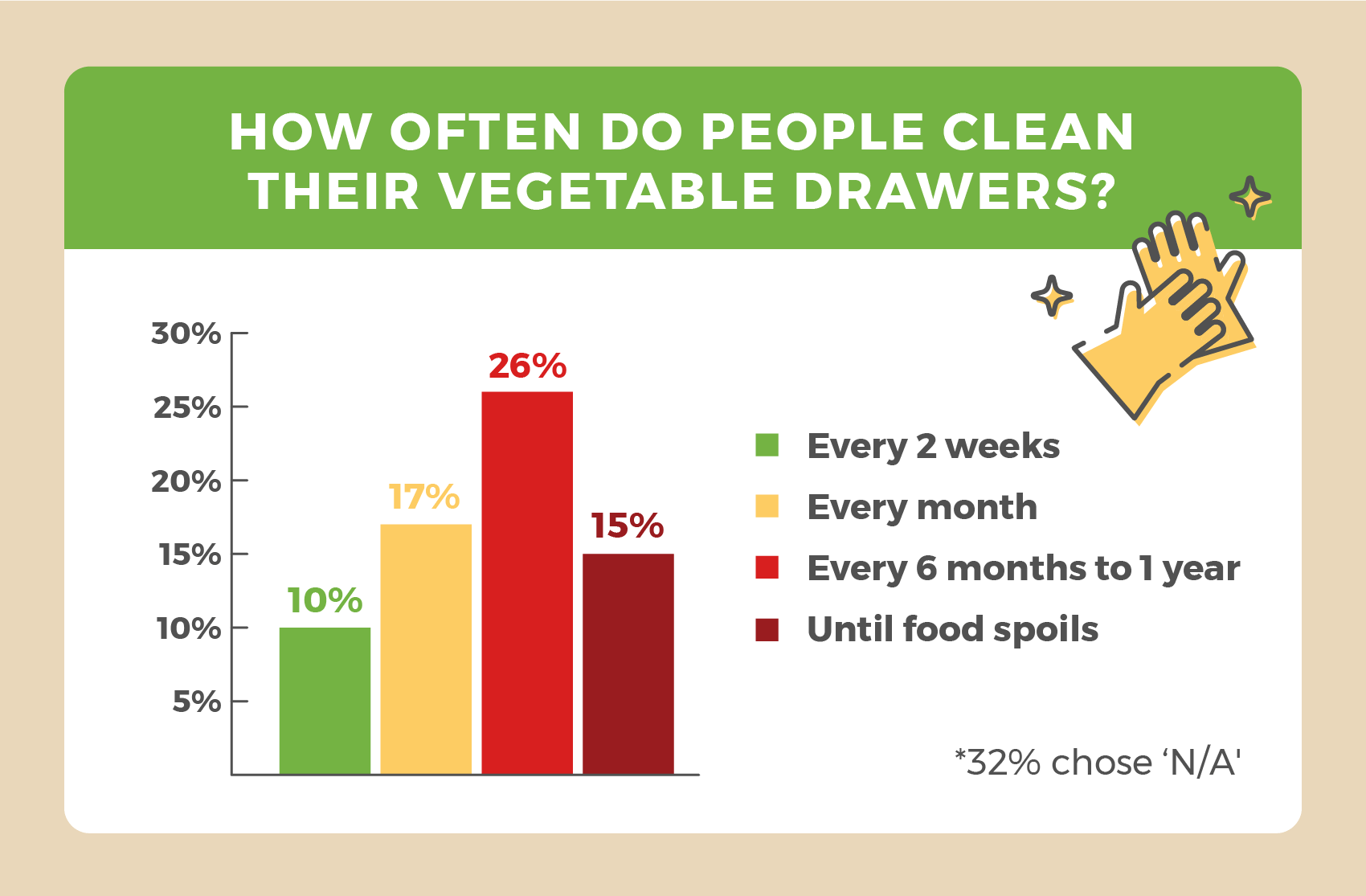
As people are more likely to routinely clean bathrooms over their refrigerator crisper drawers, toilet seats can be 45 times cleaner than where you store your food! While a public toilet seat has an average of 172 colony forming units (CFU) per square centimeter, meaning the number of viable bacteria or fungal cells present, vegetable drawers can be a breeding ground of up to 7,850 CFUs per square centimeter including harmful germs like Listeria, Salmonella, and E. coli.
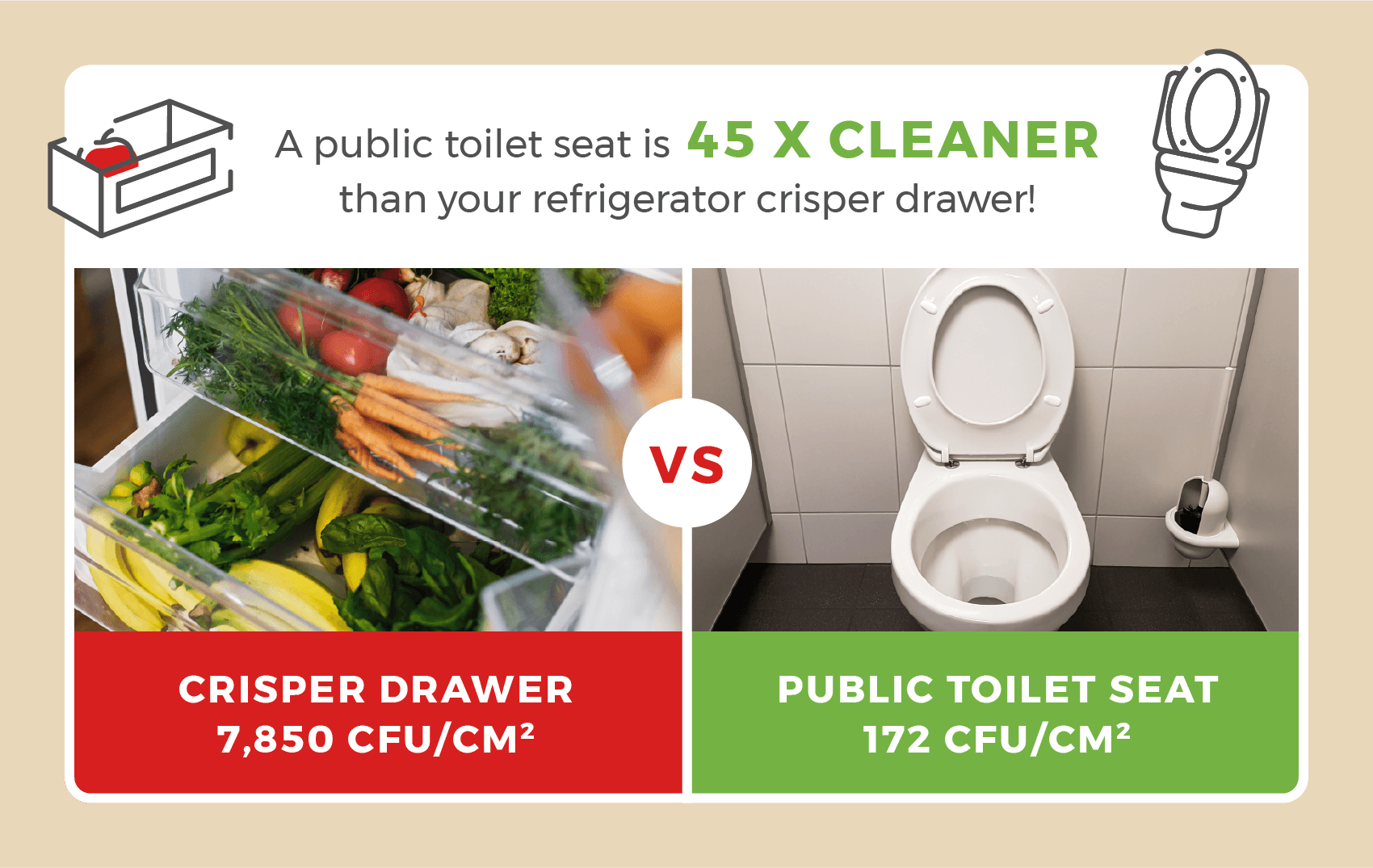
So although people are regularly rinsing their produce before eating, the number of bacteria gathered while stored in a germ-infested refrigerator drawer can pose a great risk to the household's health.
Other Germ Hubs in Your Kitchen
In addition to the germs that get on your produce from the time they're picked to when they reach your local grocery store, experts often caution consumers on cross-contamination from items in household kitchens.
As previously mentioned, moisture, food residue, and placement away from UV rays can make parts of your kitchen a bacterial paradise. Various types of colony-forming bacteria, including the dangerous pathogens mentioned earlier, have been found to thrive in certain areas of the kitchen and potentially infect the foods we consume during meal prep and consumption.
Some additional germy hot spots you should be paying some extra attention to when handling produce include cutting boards, kitchen cloths, countertops, and your kitchen sink. Check out the scary percentages of household kitchen items found to house yeast, mold, and coliform bacteria — which are common indicators of fecal contamination.
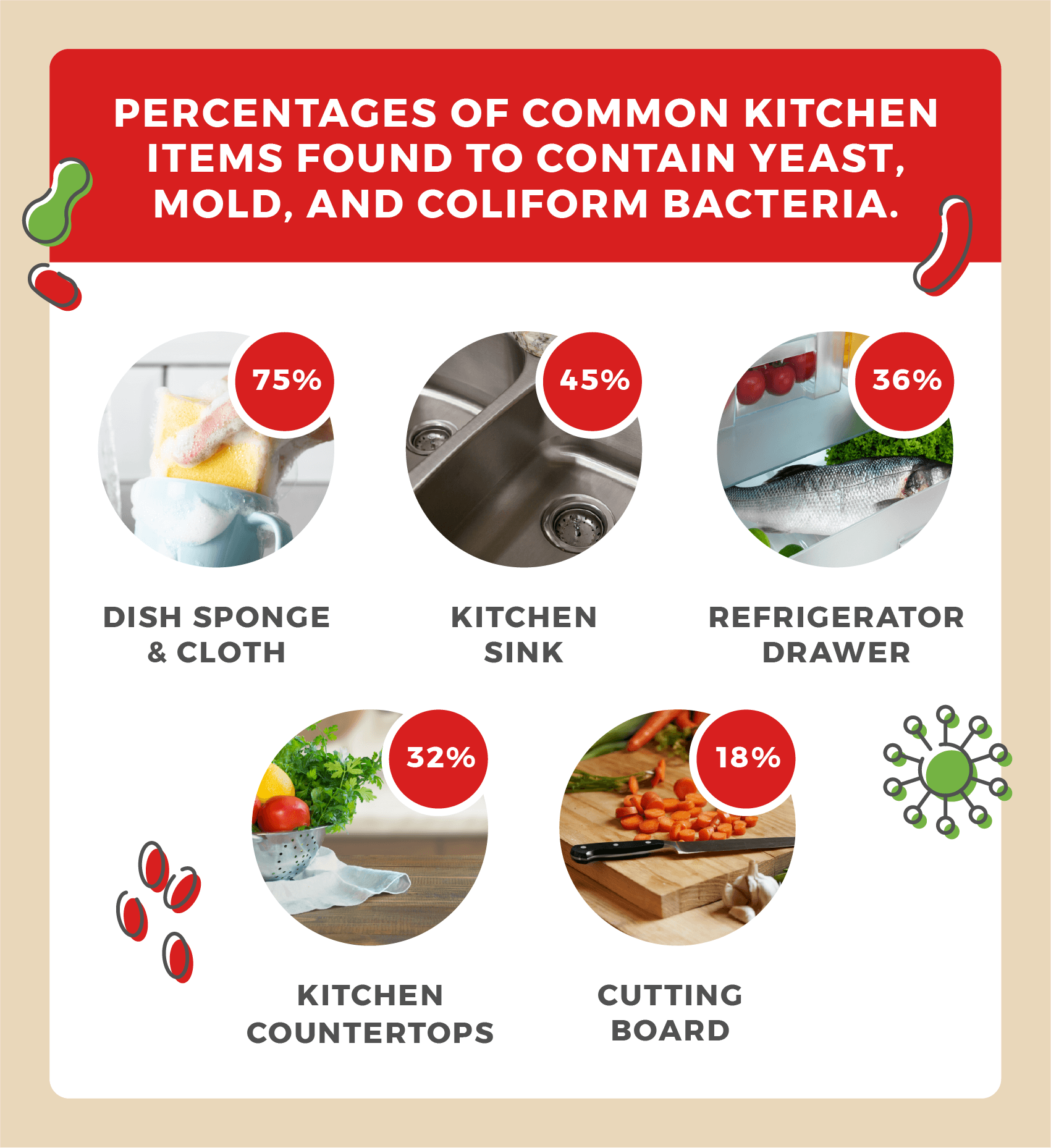
Clearly, our kitchen can create an ideal spot for germs and bacteria to grow and thrive but luckily, we have control over how often and thoroughly it's sanitized. As produce goes through many different places by the time it reaches the kitchen, below we highlight a few spots to keep in mind while you're at the grocery store.
Watch out for These
Germ-Infested Grocery Store Hotspots
Before fruits and veggies reach the produce aisle, they most likely already had contact with soil, fertilizers (including manure), pesticides, and a number of different hands. Shoppers then go and touch them with potentially dirty hands which have also been in contact with the shopping cart, reusable bags, and other products around the store.
Here are the top two dirtiest spots our produce can come in contact when we pick them at the grocery store:
- Shopping cart: 473,264 CFU/cm²
- Conveyor belt: 44,339 CFU/cm²
Compare that to the average cell phone with 100 CFUs per square centimeter, and it makes sense why foodborne diseases have been on the rise.

While doing your grocery shopping, it's pretty much impossible touching or placing your items in certain areas, but now that you're aware, be sure to bring a few sanitizing wipes to clean those spots before placing your produce.
Foodborne Outbreaks Linked
to Produce
The various processing and handling of fruits and vegetables, both during transportation and the time it reaches our kitchens, pose a great challenge in identifying and eliminating harmful pathogens linked to produce. Nevertheless, studies have found all kinds of bacteria, viruses, and parasites that are known to be harmful to human health. Below are just a few dangerous pathogens previously linked to fresh produce and foodborne outbreaks.
- Escherichia coli: has been linked to lettuce, radish, and alfalfa sprouts.
- Salmonella: has been linked to cantaloupe, sprouts, and tomato.
- Cyclospora cayetanensis: has been linked to berries.
- Hepatitis A: has been linked to lettuce, melon, and berries.
As you see from the gross list above, giving your produce a thorough wash before you place it on your kitchen countertop or cutting board, can help minimize the risk of contamination and even illness.
How to Wash Fruits and Vegetables
If you want to learn how to properly wash your produce and keep your kitchen clean, follow the simple tips below to help your family avoid catching a nasty illness or bug.

Although quite gross, germs are all around us and a part of life we simply can't avoid. However, practicing good hygiene like wiping down your countertops and kitchen cabinets, thoroughly disinfecting cutting boards and the kitchen sink, and washing your hands properly can help keep you and your family healthy.
Now, if you're ready to renew your home with new kitchen cabinets, be sure to get a free kitchen design to start the project on the right track.
METHODOLOGY
This survey was conducted for Kitchen Cabinet Kings through Google Consumer Surveys, using a sample of no less than 1,500 respondents. The average RMSE score was 4.8%. The survey ran online during April 2020.
Sources: Wiley | NSF | NCBI | CDC | Food Protection | Colorado State University | Canadian Journal of Infectious Diseases | Sonostream | Reuse This Bag | Food Safety





 min
min

